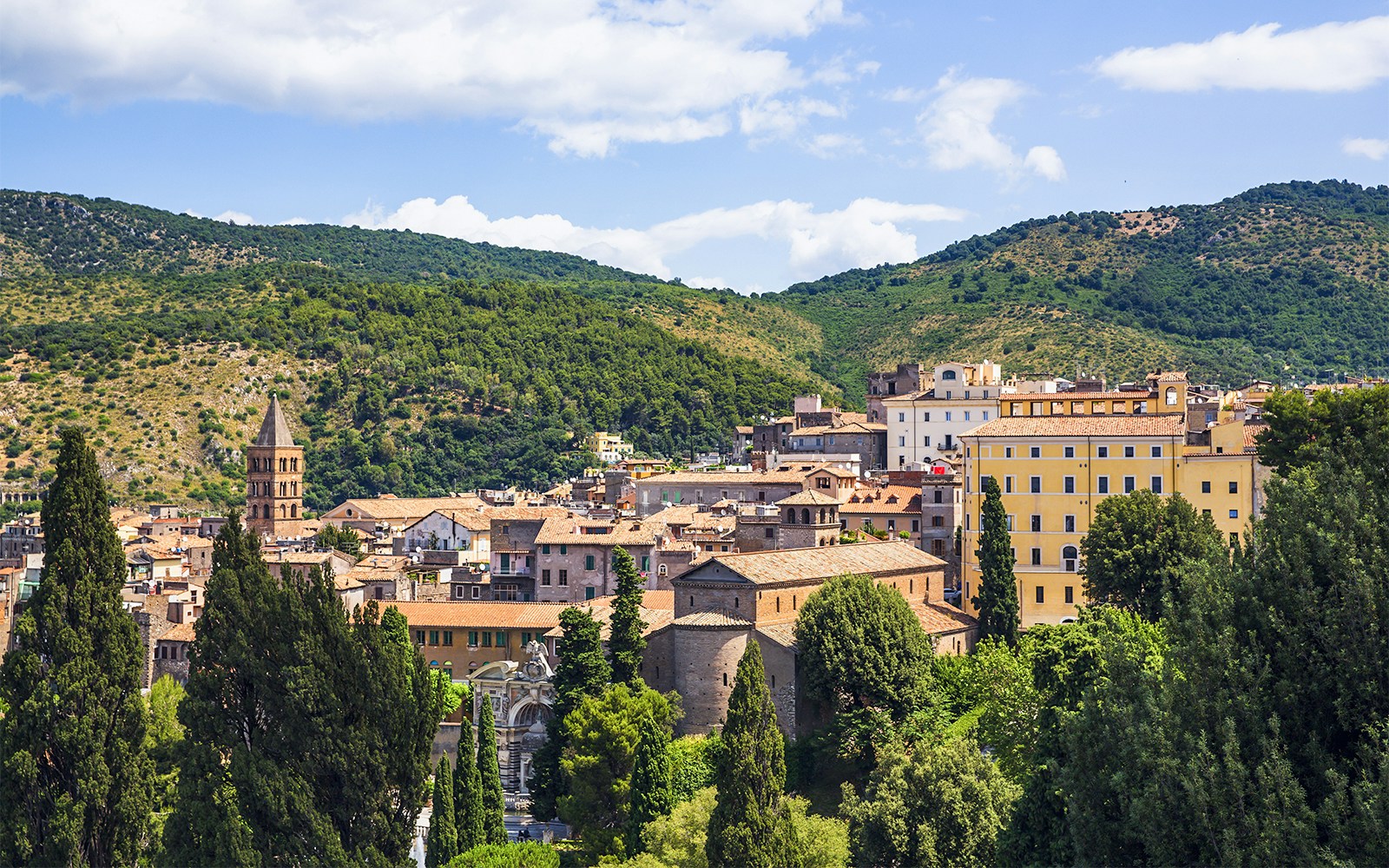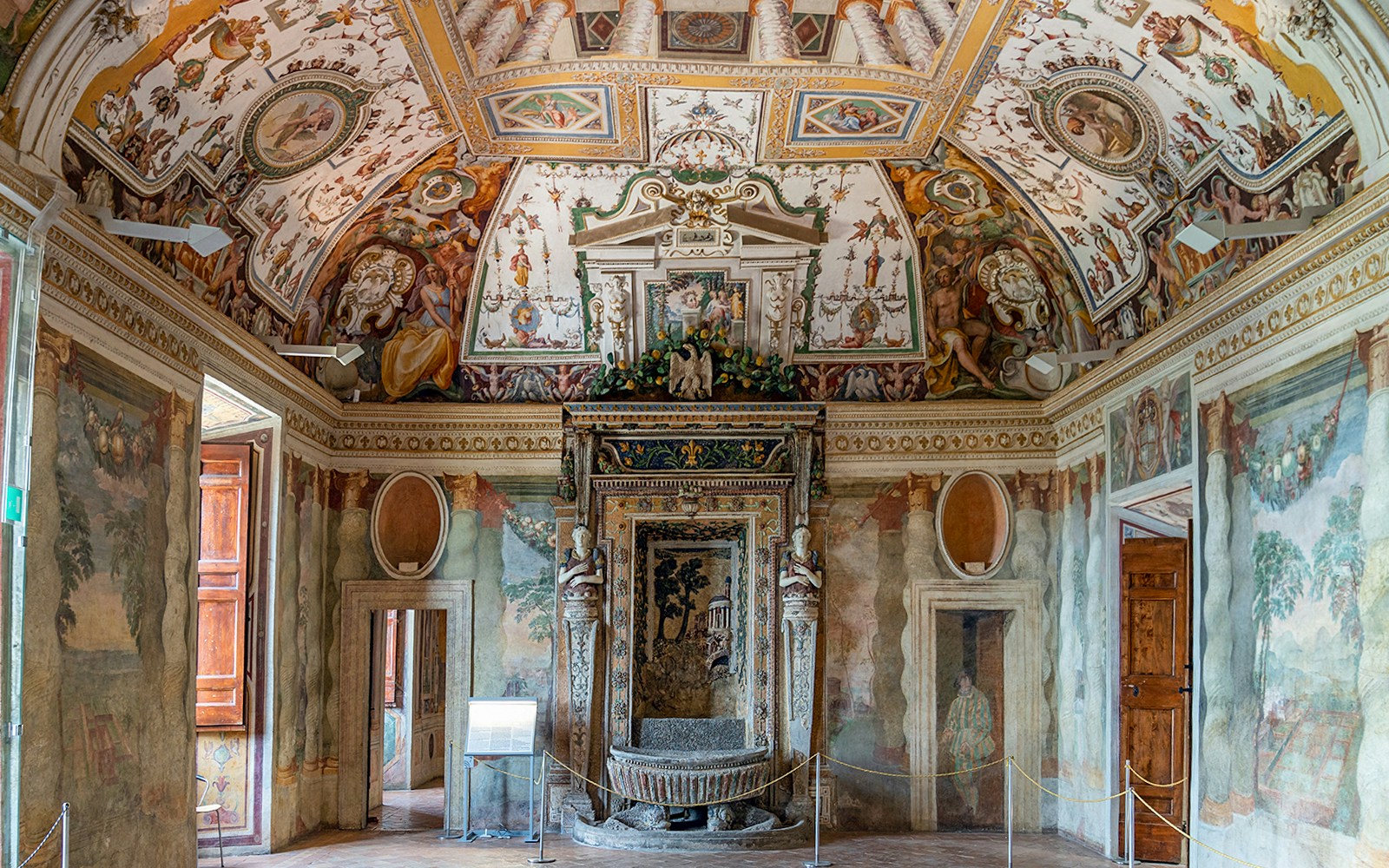The Vialone is a grand terrace connecting the upper and lower gardens, offering panoramic views. Its balustrades and stonework create an amphitheater-like effect, perfect for events and leisurely strolls.

Start your visit at the elegant courtyard, featuring beautiful architecture and setting the tone for the grandeur inside.

The gardens at Villa d'Este are a masterpiece of Renaissance landscape design, renowned for their stunning fountains, terraces, and lush greenery. Here are some highlights:
It symbolizes the eleventh attempt of Hercules, who killed the 100-headed dragon named Ladon to get the golden apples from the Garden of the Esperidi for Euristo. The sound produced by the fountain's hydraulic when bursting water resembles that of cannons fired.
The Fountain of the Organ, constructed in 1571, draws water to power instruments like pipes and trumpets through a complex internal system. Musical compositions are timed to the water jets.
The Hundred Fountains are prominently displayed along a promenade that runs beside the mansion. There are about 300 spouts shooting water streams at various heights. The whole ensemble is a fan-favorite.
It was erected between 1565 and 1569 in the Southwest corner of the garden. This playful fountain features a small owl perched on a tree stump, with water cleverly disguised to appear like its droppings. The unexpected and humorous use of water adds a touch of whimsy to the gardens.
This grand fountain is a dramatic centerpiece of the Lower Gardens, featuring powerful jets that shoot water high into the air, creating a mesmerizing display.
This miniature replica of Rome features iconic landmarks like the Colosseum and St. Peter's Basilica, all playfully reimagined in water.
Designed by the famous sculptor Gian Lorenzo Bernini, this fountain features a large seashell overflowing with water from a central cup. The seemingly natural rock formation of the shell cleverly disguises the man-made structure.
Villa d'Este's captivating beauty hasn't just captured the hearts of history buffs and garden enthusiasts. This stunning Renaissance estate has also graced the silver screen, adding a touch of Italian grandeur to several films:
Villa d'Este is known for its stunning gardens featuring hundreds of fountains, waterfalls, and terraces, as well as its impressive Renaissance architecture. Water plays a starring role with cascading fountains, grottoes, and reflecting pools adorning the terraced gardens. This innovative water feature design, coupled with the overall artistic vision, influenced gardens across Europe and earned Villa d'Este its place as a UNESCO World Heritage Site.
Villa d'Este is located in the town of Tivoli, which is about 30 kilometers (19 miles) east of Rome, Italy (approximately 45 minute - 1 hour drive from Rome to Villa d'Este and 30-60 minutes with trains/buses).
While the idea is intriguing and adds to the mystique of the villa, sadly, there are no hidden rooms or passages inside the Villa d'Este.
Villa d'Este features beautiful Renaissance architecture and contains many ornately decorated rooms and chambers with frescoes, paintings, and sculptures. However, the main attraction of the villa is its stunning gardens, which are filled with hundreds of fountains, waterfalls, and terraces that are considered to be some of the finest examples of Italian garden design in the world.
Villa d'Este features exquisite interior decoration that includes frescoes, stucco work, marble sculptures, and other ornamental features.
There are over 500 fountains ornamenting the Villa d’Este Tivoli.
The water features at Villa d'Este are renowned for their complexity and beauty, functioning ingeniously without modern pumps. The entire hydraulic system relies on gravity, sourcing water from the higher-elevated River Aniene. A network of aqueducts and channels transports water to large cisterns and reservoirs that regulate the supply. Hidden pipes and conduits distribute water throughout the gardens, while siphons and water pressure manipulation enable the fountains to shoot water high into the air.
The story of Villa d'Este's origins goes back to before it even belonged to the famous d'Este family. The site where the Villa d'Este stands was originally occupied by a Benedictine monastery. In the 16th century, Cardinal Ippolito II d'Este, a powerful figure in the Church, was appointed governor of nearby Tivoli. He desired a grand residence and set on a venture to remodel his initially allotted monastery. The monastery wasn't entirely demolished, but rather converted and incorporated into the design of the new villa. This explains why some parts of the Villa d'Este might have a slightly different architectural style.
The Fountain of Rometta, also called "Little Rome," at Villa d'Este is a fascinating representation with a rich backstory. The water features were designed to represent the journey of the Tiber River. Designed by Pirro Ligorio in the 16th century, the miniature city included recreations of famous Roman landmarks, though some haven't survived. You might find the statue of Rome Victorious, the iconic symbol of the city, along with the legendary She-Wolf nursing Romulus and Remus. Sadly, replicas of triumphal arches like those of Titus, Septimius Severus, and Constantine, as well as Trajan's Column, are lost. Interestingly, when the fountain was built, the real city of Rome was visible in the distance behind it. This created a unique blend of reality and representation, further emphasizing the connection between the Villa d'Este and the Eternal City.
Villa d'Este's plant choices were carefully selected to complement the architecture and water features. Evergreens like cypress trees provided structure, citrus trees offered fragrance and beauty, and seasonal flowers added bursts of color. While the core design of evergreens, citrus, and seasonal flowers remains, specific plant varieties may have changed to adapt to climate or incorporate new species. Even with some modern touches, the focus stays true to the Renaissance spirit: creating a harmonious and visually stunning backdrop for the villa's grand design.
The best time to visit Villa d'Este to avoid crowds and see the gardens at their peak is during the spring and fall seasons. The period from March to October is generally the most favorable for visiting, as the weather is pleasant and the gardens are lush. Spring (April to June) and autumn (September to October) are ideal times, as the weather is still pleasant but there are fewer visitors compared to the peak summer season. Early morning or late afternoon visits are recommended to avoid the largest crowds.
While the Villa d'Este itself doesn't hold special exhibitions throughout the year, the surrounding town of Tivoli does come alive with various events and festivals. Here are a couple to consider when planning your trip:
The dress code for visiting Villa d'Este is generally business casual and comfortable. Outfits like swimwear, bare-chested, and shorts are not permitted for men or women.
While, there are some tricky terrains, a large portion of Villa d'Este is wheelchair accessible. The upper terrace of the garden is accessible by lift from street level. Electric vehicles are available for exploring gardens & fountains.
Yes, guided tours of the villa and gardens are available at Villa d'Este. These tours are led by professional guides who can provide detailed information about the history, architecture, and art of the site.
Approximately three hours are enough to explore Vista d’Este and Tivoli gardens.
Villa d’Este Skip-the-Line Tickets
Combo: Villa d'Este + Hadrian's Villa Skip-the-Line Tickets
Villa d’Este Skip-the-Line Tickets with Digital Audio Guide
From Rome: Villa d'Este and Hadrian's Villa Day Trip
The villa features Renaissance optical illusions that shift as you change your perspective.
The palace has a unique “water organ” that uses water pressure to play music through reeds, once enhanced by bellows.
The Hundred Fountains garden features a long wall with numerous water spouts, actually around 500, creating a stunning cascading water display.
RECOMMENDED DURATION
2 hours
VISITORS PER YEAR
600000
TICKETS
From $19.79
EXPECTED WAIT TIME - STANDARD
30-60 mins (Peak), 0-30 mins (Off Peak)
UNESCO YEAR
2001